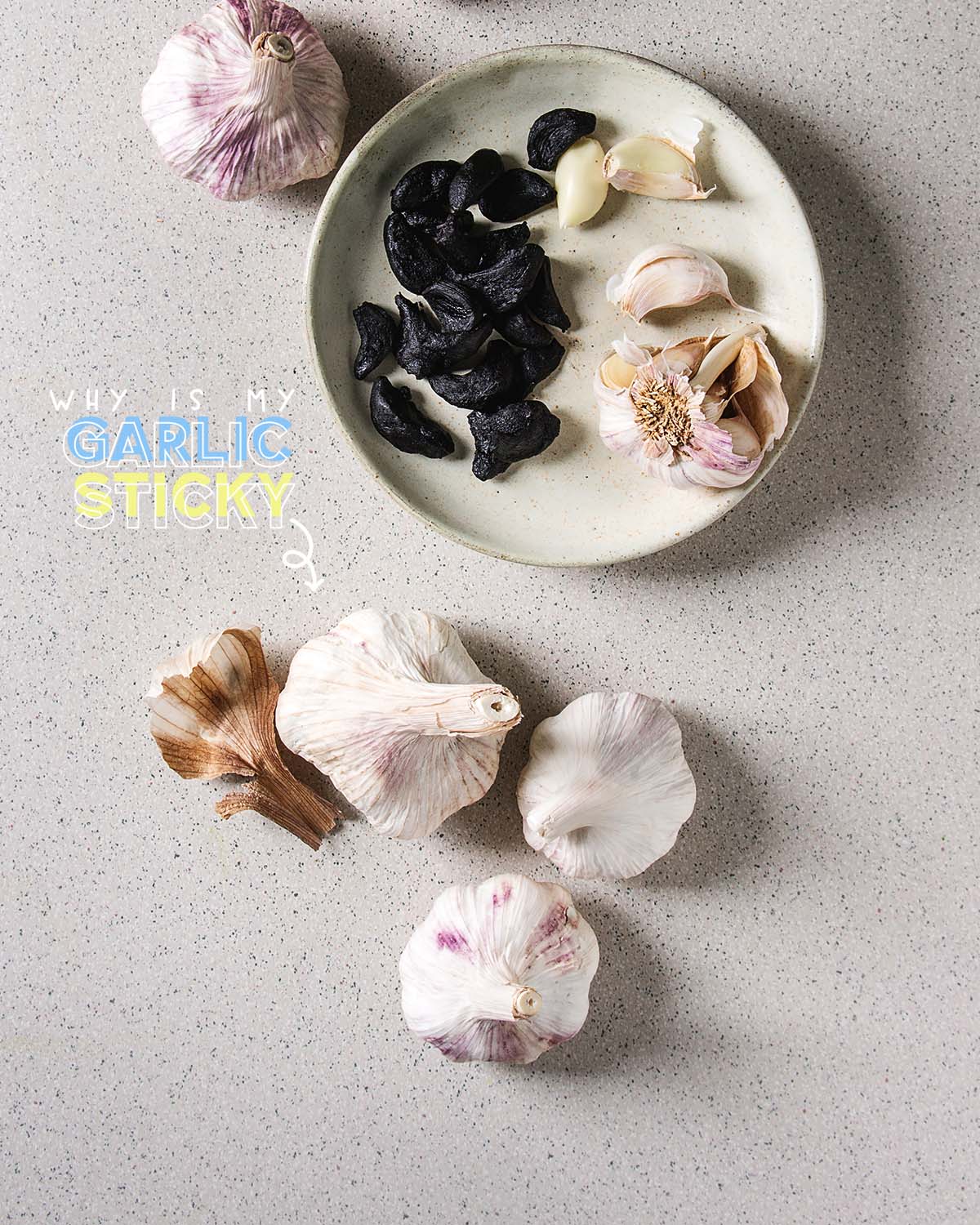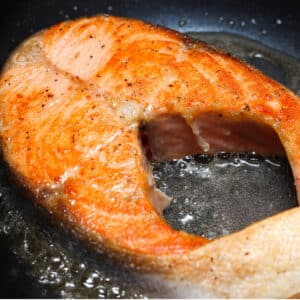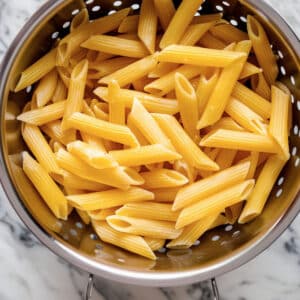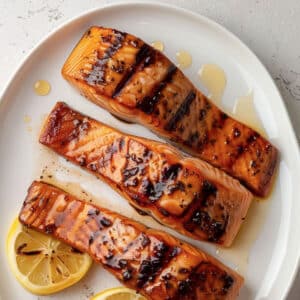Ever try to peel the garlic and end up with sticky cloves all over your hands? It's not your fault. Garlic is sticky by nature. That signature stickiness results from so many factors, ranging from the type of garlic to its growing environment. Let's look at why garlic is sticky and how you can avoid those pesky messes.
Here's why garlic is sticky.
Garlic cloves begin to break down as soon as they are peeled, forming new compounds, one of which is called diallyl trisulfide. This substance gives garlic its signature smell and flavor, but it can also be responsible for its sticky nature.
But one of the other causes of sticky garlic is the sugar content. The sugar in garlic is called fructose. When you chop the garlic, the fructose is exposed to air and reacts with oxygen to form a sticky substance called fructan.

The amount of fructan in garlic varies depending on the variety of garlic and how it was grown. For example, garlic that has been stored for a long time or garlic that has been exposed to warm temperatures during growth will have more fructan.
Fructan is not only responsible for making garlic sticky, but it also contributes to the formation of new cloves. When a garlic clove is exposed to light, a plant hormone called gibberellin is produced.
Gibberellin triggers the formation of new cloves by breaking down the fructan.
So, the next time you notice that your garlic is sticky, you can thank the sugar fructose for that!
What is fructan?
Fructan is a polymer of fructose molecules. Garlic, onions, wheat, and bananas are just a few food items that contain this substance. Despite being indigestible by humans, fructan has a prebiotic effect, which encourages the growth of beneficial bacteria in the gut. Fructan comes under the FODMAP umbrella and can be problematic for people with irritable bowel syndrome (IBS).
How does fructan make garlic sticky?
Chopped garlic exposes fructose to air, which reacts with oxygen to form fructan, a sticky substance. It can be challenging to clean off surfaces, and the residue can even get on your knife blade.
There can be differences in fructan levels between garlic varieties and cultivation methods. An example would be garlic stored for a long time, or garlic exposed to warm temperatures during growth will have more fructan.
Read:
What are the benefits of fructan?
Fructan is indigestible by humans and is thought to have a prebiotic effect, meaning it promotes the growth of beneficial bacteria in the gut. In addition, fructan has been shown to have antioxidant, anti-inflammatory, and anticancer properties.
How to prevent garlic pieces from sticking to the knife blade
When you're chopping garlic, have you ever noticed that sometimes it could be a little bit sticky? And that no matter how many times you wash your knife, the garlic seems to stick around? Well, there's a scientific reason for that!
Sugar content. As soon as the garlic is chopped, the sugar is released, leaving a sticky residue. Surfaces with sticky residue can be challenging to clean, and knife blades may become coated. Fortunately, there are a few things you can do to prevent the garlic from sticking in the first place.
Below are a few tips:
1 Coat knife with oil
One way to prevent garlic from sticking is to coat your knife with oil before cutting. This will create a barrier between the garlic and the blade and make it easier to slice through the cloves.
2 Add coarse salt to the garlic
After roughly chopping the garlic, sprinkle it with some coarse salt. This will absorb the moisture and help to prevent the garlic from sticking.
Under the microscope, salt looks like tiny razor blades that can cut through the surface of the garlic.
The salt does two things:
- It helps dry out the garlic and acts as an abrasive.
- The abrasive action will help clean the garlic off your knife blade. It disrupts the surface of the garlic and prevents it from sticking. You can then brush the salt away.
3 Garlic press
First, try to use a garlic press - this tool will crush the cloves without releasing as much Allicin. You can also soak the cloves in water for a few minutes before peeling them. This won't reduce the overall stickiness of the garlic, but it will help to remove any lingering residue.
4 Use a plastic or ceramic knife
The best way to prevent garlic from sticking is to use a plastic or ceramic knife. These knives have a smoother surface than metal knives and won't allow the garlic to stick as quickly.
5 Serrated knife
If you don't have a plastic or ceramic knife, you can also try using a serrated knife. The teeth on a serrated knife will help grip the garlic and prevent it from sticking.
6 Use a cutting board with grooves
If you don't have a plastic or ceramic knife, you can try using a cutting board with grooves. The groove will catch the sticky garlic juices and prevent them from transferring to your knife blade.
7 Put the garlic in the freezer for a few minutes before chopping
You can also put the garlic in the freezer for a few minutes before chopping if you have time. This will firm up the cloves and make them easier to chop. Just be sure to chop the garlic while it's still frozen. Otherwise, it will thaw out and become sticky again.
These are a few tips to help you avoid sticky garlic situations in the kitchen! With a little bit of prep work, you'll be able to cut through cloves.
Read:
What does it mean if garlic is sticky?
When garlic is fresh, the sugar content is high. Once you cut the garlic, you break open cells and release the sugar inside them. The sugar then sticks to your knife (or anything else it comes into contact with), making it seem like the garlic is "sticking" to the blade. This sticky residue is a good thing - it's a sign that you're using fresh garlic!
How to remove garlic smell from your hands
After chopping garlic, you can do a few things to prevent the smell from transferring to your hands.
1 Milk-soaked towel
Finally, you can try using a milk-soaked towel to remove the garlic smell from your hands. Simply soak a towel in milk and then rub it over your hands. The milk will help to neutralize the odor of the garlic. Milk is a natural neutralizer and can help remove the smell of garlic from your hands. The milk will help break down the sulfur molecules responsible for the odor.
How to do it:
- Soak a towel in milk.
- Rub the towel over your hands.
2 Rinse your hands with soap and water.
Soap and water will also remove the garlic smell from your hands. The soap will break up the oils on your skin, carrying the garlic odor. Be sure to use a strong-smelling soap such as dish soap or hand soap. The high concentration of soap might be drying your skin, so follow up with a moisturizer if needed.
How to do it:
- Wet your hands with warm water and add soap.
- Rub your hands together for 20 to 30 seconds, getting in between your fingers and under your nails.
- Rinse your hands thoroughly with warm water.
3 Lemon juice
You can also try using lemon juice to remove the garlic smell from your hands. The acid in these liquids will break down the oils that carry the garlic odor.
This is because citrus oils contain limonene, a strong scent that can mask other odors. Aside from that, citrus fruits' acidic nature can also help break down the sulfur molecules in garlic. Also, the citrus oils will help remove the garlic smell from your hands. As a result, the garlic smell will be less intense.
How to do it:
- Cut a lemon in half and rub it all over your hands.
- You can also try soaking your hands in a bowl of lemon juice for about 5 minutes.
4 Rub your hands on a piece of stainless steel cutlery
The sulfur in garlic will react with the chromium in stainless steel to form a new compound with no odor. This method works in the same way as rubbing your hands on a stainless steel sink or countertop. The main difference is that you're using a small piece of cutlery instead of a large surface area. You can use a stainless steel knife, fork, or spoon to be effective.
How to do it:
- Rub the piece of stainless steel cutlery all over your hands.
- You can also try holding the piece of stainless steel under running water while you rub your hands together.
5 Baking soda
Baking soda is another common household item that you can use to remove the garlic odor from your hands. Baking soda is a mild alkali that will neutralize the acids on your skin that carry the garlic odor. It can also absorb moisture, which will help to dry out your hands.
How to do it:
- Make a paste by mixing equal parts baking soda and water.
- Rub the paste all over your hands and let it sit for about 5 minutes.
- Rinse it off with soap and water.
6 Rinse your hands with rubbing alcohol
Rubbing alcohol will also remove the garlic smell from your hands. The alcohol will evaporate quickly, taking the garlic odor with it. Be sure to use a 70% isopropyl alcohol solution for this method.
How to do it:
- Soak a cotton ball in rubbing alcohol and rub it on your hands.
- You can also pour some rubbing alcohol into a bowl and soak your hands in it for a few minutes.
- Rinse with water when you're finished. Allowing your hands to air-dry will also help remove the garlic smell.
7 Rinse your hands with vinegar
Vinegar is another effective way to remove the garlic smell from your hands. Use strong-smelling vinegar such as apple cider vinegar or white vinegar. The acid in the vinegar will break down the oils carrying the garlic odor. The high concentration of vinegar might be drying your skin, so follow up with a moisturizer if needed.
How to do it:
- Soak your hands in a bowl of vinegar for about 5 minutes.
- Rinse it off with soap and water.
8 Use mouthwash
You can also use mouthwash to remove the garlic smell from your hands. The alcohol in the mouthwash will evaporate quickly, taking the garlic odor. Be sure to use a mint-flavored mouthwash, so you don't end up with bad breath.
How to use mouthwash to remove the garlic smell from your hands:
- Pour a small amount of mouthwash into your palm.
- Rub your hands together for a few seconds.
- Rinse your hands with water.
9 Use a hand sanitizer.
Garlic smell can also be removed by using hand sanitizer. Hand sanitizer contains alcohol that evaporates quickly, removing the garlic smell. Be sure to use a hand sanitizer with at least 60% alcohol. Whenever you use alcohol, be sure to follow up with a moisturizer.
How to do it:
- Pour a small amount of hand sanitizer into your palm.
- Rub your hands together for a few seconds.
10 Use a bleach solution
If you're desperate, you can also try using a bleach solution to remove the garlic smell from your hands. Bleach will remove the compounds that cause garlic to smell. Be sure to use a bleach solution with at least 10% bleach. Wear gloves when using this method, then wash your hands thoroughly with soap and water afterward.
How to do it:
- Mix 1 part bleach with 9 parts water.
- Soak your hands in the solution for a few minutes.
- Rinse your hands with soap and water.
Other factors that cause garlic to be sticky
There are several reasons why garlic can end up being sticky. So, whether you're a home cook who wants to avoid sticky garlic or just curious about this culinary phenomenon, let's find out!
1 The main culprit behind garlic's stickiness is a substance called Allicin. This sulfur-containing compound is responsible for garlic's intense flavor and aroma. When garlic cloves are crushed or cut, Allicin is released. Allicin starts to break down almost immediately, but the process is accelerated by heat, acidity, and water. That's why cooked garlic isn't as strong as raw garlic.
Allicin isn't just stinky and sticky - it also has some pretty impressive health benefits. This compound has been shown to fight infections, lower cholesterol levels, and reduce blood pressure. So even though it can be a pain to deal with, we think garlic's stickiness is worth it!
2 When Allicin reacts with oxygen, it forms a new compound called diallyl trisulfide. This compound is even more sticky than Allicin and can be hard to remove from surfaces. It is also responsible for the 'after-smell' of garlic that can linger on your breath and in your kitchen long after you've cooked with it.
3 If you store garlic in oil, Allicin, diallyl trisulfide, and fructose can create an incredibly sticky situation. One reason why home-canned garlic is so challenging to work with.
4 Some varieties of garlic are stickier than others. For instance, hardneck garlic (the kind with a woody stalk in the center) is generally stickier than softneck garlic (the kind you typically find in supermarkets). This is because hard neck garlic contains more Allicin than soft neck garlic.
5 Garlic sitting out for a while is also stickier than fresh garlic. This is because the allicin and diallyl trisulfide have had time to react with oxygen, making them even more sticky.
6 Finally, if you try to remove garlic skin by rubbing it with your fingers, you'll have sticky garlic all over your hands. This is because the skin contains a high concentration of allicin and diallyl trisulfide. The best way to remove garlic skin is to use a knife or peeler.




